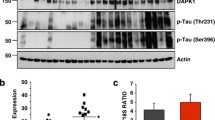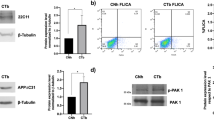Abstract
Glycogen synthase kinase GSK-3β has been identified as one of the major candidates mediating tau hyperphosphorylation at the same sites as those present in tau protein in brain from Alzheimer′s disease (AD) patients. However, the signal transduction pathways involved in the abnormal activation of GSK-3β, have not been completely elucidated. GSK-3β activity is repressed by the canonical Wnt signaling pathway, but it is also modulated through the PI3K/Akt route. Recent studies have suggested that Wnt signaling might be involved in the pathophysiology of AD. On the other hand, modulators of the PI3K pathway might be reduced during aging leading to a sustained activation of GSK-3β, which in turn would increase the risk of tau hyperphosphorylation. The role of Wnt and PI3K signaling inhibition on the extent of tau phosphorylation and neuronal morphology has not been completely elucidated. Thus, in the present investigation we analyzed the effects of different negative modulators of the Wnt and the PI3K pathways on GSK-3β activation and phosphorylation of tau at the PHF-1 epitope in cortical cultured neurons and hippocampal slices from adult rat brain. Changes in the microtubule network were also studied. We found that a variety of Wnt and PI3K inhibitors, significantly increased tau phosphorylation at the PHF-1 site, induced the disarrangement of the microtubule network and the accumulation of tau within cell bodies. These changes correlated with alterations in neuronal morphology.





Similar content being viewed by others
References
Selkoe DJ (2000a) The genetics and molecular pathology of Alzheimer’s disease: roles of amyloid and the presenilins. Neurol Clin 18:903–922
Selkoe DJ (2000b) Toward a comprehensive theory for Alzheimer’s disease. Hypothesis: Alzheimer’s disease is caused by the cerebral accumulation and cytotoxicity of amyloid β-protein. Ann NY Acad Sci 924:17–25
Iqbal K, Grundke-Iqbal I (2006) Discoveries of tau, abnormally hyperphosphorylated tau and others of neurofibrillary degeneration: a personal historical perspective. J Alzheimers Dis 9:219–242
Lee VM, Goedert M, Trojanowski JQ (2001) Neurodegenerative tauopathies. Annu Rev Neurosci 24:1121–1159
Ishiguro K, Shiratsuchi A, Sato S et al (1993) Glycogen synthase kinase 3 β is identical to tau protein kinase I generating several epitopes of paired helical filaments. FEBS Lett 325:167–172
Lovestone S, Reynolds CH (1997) The phosphorylation of tau: a critical stage in neurodevelopment and neurodegenerative processes. Neuroscience 78:309–324
Pei JJ, Tanaka T, Tung YC et al (1997) Distribution, levels, and activity of glycogen synthase kinase-3 in the Alzheimer disease brain. J Neuropathol Exp Neurol 56:70–78
Grimes CA, Jope RS (2001) CREB DNA binding activity is inhibited by glycogen synthase kinase-3 β and facilitated by lithium. J Neurochem 78:1219–1232
Wodarz A, Nusse R (1998) Mechanisms of Wnt signaling in development. Annu Rev Cell Dev Biol 14:59–88
Chong ZZ, Maiese K (2004) Targeting WNT, protein kinase B, and mitochondrial membrane integrity to foster cellular survival in the nervous system. Histol Histopathol 19:495–504
Li F, Chong ZZ, Maiese K (2005) Vital elements of the Wnt-Frizzled signaling pathway in the nervous system. Curr Neurovasc Res 2:331–340
Salinas PC (1999) Wnt factors in axonal remodelling and synaptogenesis. Biochem Soc Symp 65:101–109
Lie DC, Colamarino SA, Song HJ et al (2005) Wnt signalling regulates adult hippocampal neurogenesis. Nature 437:1370–1375
Chen J, Park CS, Tang SJ (2006) Activity-dependent synaptic Wnt release regulates hippocampal long term potentiation. J Biol Chem 281:11910–11916
Speese SD, Budnik V (2007) Wnts: up-and-coming at the synapse. Trends Neurosci 30:268–275
Cotter D, Kerwin R, al-Sarraji S et al (1998) Abnormalities of Wnt signalling in schizophrenia -evidence for neurodevelopmental abnormality. Neuroreport 9:1379–1383
Miyaoka T, Seno H, Ishino H (1999) Increased expression of Wnt-1 in schizophrenic brains. Schizophr Res 38:1–6
De Ferrari GV, Inestrosa NC (2000) Wnt signaling function in Alzheimer’s disease. Brain Res Rev 33:1–12
Wehrli M, Dougan ST, Caldwell K et al (2000) arrow encodes an LDL-receptor-related protein essential for Wingless signaling. Nature 407:527–530
Ikeda S, Kishida S, Yamamoto H et al (1998) Axin, a negative regulator of the Wnt signaling pathway, forms a complex with GSK-3beta and beta-catenin and promotes GSK-3β-dependent phosphorylation of β-catenin. EMBO J 17:1371–1384
Willert K, Nusse R (1998) β-catenin: a key mediator of Wnt signaling. Curr Opin Genet Dev 8:95–102
Dale TC (1998) Signal transduction by the Wnt family of ligands. Biochem J 329:209–223
Novak A, Dedhar S (1999) Signaling through β-catenin and Lef/Tcf. Cell Mol Life Sci 56:523–537
van Noort M, Clevers H (2002) TCF transcription factors, mediators of Wnt-signaling in development and cancer. Dev Biol 244:1–8
Rodgers EE, Theibert AB (2002) Functions of PI 3-kinase in development of the nervous system. Int J Dev Neurosci 20:187–197
Brunet A, Datta SR, Greenberg ME (2001) Transcription-dependent and -independent control of neuronal survival by the PI3K-Akt signaling pathway. Curr Opin Neurobiol 11:297–305
Cantley LC (2002) The phosphoinositide 3-kinase pathway. Science 296:1655–1657
Lucas FR, Salinas PC (1997) WNT-7a induces axonal remodeling and increases synapsin I levels in cerebellar neurons. Dev Biol 192:31–44
Hall AC, Lucas FR, Salinas PC (2000) Axonal remodeling and synaptic differentiation in the cerebellum is regulated by WNT-7a signaling. Cell 100:525–535
Rosso SB, Sussman D, Wynshaw-Boris A et al (2005) Wnt signaling through Dishevelled, Rac and JNK regulates dendritic development. Nat Neurosci 8:34–42
Alvarez G, Muñoz-Montaño JR, Satrústegui J et al (1999) Lithium protects cultured neurons against beta-amyloid-induced neurodegeneration. FEBS Lett 453:260–264
Garrido JL, Godoy JA, Alvarez A et al (2002) Protein kinase C inhibits amyloid β peptide neurotoxicity by acting on members of the Wnt pathway. FASEB J 16:1982–1984
Alvarez AR, Godoy JA, Mullendorff K et al (2004) Wnt-3a overcomes β-amyloid toxicity in rat hippocampal neurons. Exp Cell Res 297:186–196
Caricasole A, Copani A, Caraci F et al (2004) Induction of Dickkopf-1, a negative modulator of the Wnt pathway, is associated with neuronal degeneration in Alzheimer’s brain. J Neurosci 24:6021–6027
Scali C, Caraci F, Gianfriddo M et al (2006) Inhibition of Wnt signaling, modulation of tau phosphorylation and induction of neuronal cell death by DKK1. Neurobiol Dis 24:254–265
Li X, Lu F, Tian Q et al (2006) Activation of glycogen synthase kinase-3 induces Alzheimer-like tau hyperphosphorylation in rat hippocampus slices in culture. J Neural Transm 113:93–102
Hernández-Fonseca K, Massieu L (2005) Disruption of endoplasmic reticulum calcium stores is involved in neuronal death induced by glycolysis inhibition in cultured hippocampal neurons. J Neurosci Res 82:196–205
Brewer GJ, Torricelli JR, Evege EK et al (1993) Optimized survival of hippocampal neurons in B27-supplemented neurobasal, a new serum-free combination. J Neurosci Res 35:567–576
Gong CX, Lidsky T, Wegiel J et al (2001) Metabolically active rat brain slices as a model to study the regulation of protein phosphorylation in mammalian brain. Brain Res Protoc 6:134–140
Arias C, Arrieta I, Tapia R (1995) β-Amyloid peptide fragment 25–35 potentiates the calcium-dependent release of excitatory amino acids from depolarized hippocampal slices. J Neurosci Res 41:561–566
Kawano Y, Kypta R (2003) Secreted antagonists of the Wnt signalling pathway. J Cell Sci 116:2627–2634
Jones SE, Jomary C (2002) Secreted Frizzled-related proteins: searching for relationships and patterns. Bioessays 24:811–820
Sperber BR, Leight S, Goedert M et al (1995) Glycogen synthase kinase-3 β phosphorylates tau protein at multiple sites in intact cells. Neurosci Lett 197:149–153
Frame S, Cohen P (2001) GSK3 takes centre stage more than 20 years after its discovery. Biochem J 359:1–16
Bhat RV, Budd Haeberlein SL, Avila J (2004) Glycogen synthase kinase 3: a drug target for CNS therapies. J Neurochem 89:1313–1317
Shaw M, Cohen P, Alessi DR (1997) Further evidence that the inhibition of glycogen synthase kinase-3β by IGF-1 is mediated by PDK1/PKB-induced phosphorylation of Ser-9 and not by dephosphorylation of Tyr-216. FEBS Lett 416:307–311
Alger BE, Nicoll RA (1982) Feed-forward dendritic inhibition in rat hippocampal pyramidal cells studied in vitro. J Physiol 328:105–123
Inestrosa NC, Varela-Nallar L, Grabowski CP et al (2007) Synaptotoxicity in Alzheimer’s disease: the Wnt signaling pathway as a molecular target. IUBMB Life 59:316–321
Caruso A, Motolese M, Iacovelli L et al (2006) Inhibition of the canonical Wnt signaling pathway by apolipoprotein E4 in PC12 cells. J Neurochem 98:364–371
Welsh GI, Foultone EJ, Young SW et al (1994) Wortmannin inhibits the effects of insulin and serum on the activities of glycogen synthase kinase-3 and mitogen-activated protein kinase. Biochem J 303:15–20
Morishima-Kawashima M, Hasegawa M, Takio K et al (1995) Proline-directed and non-proline-directed phosphorylation of PHF-tau. J Biol Chem 270:823–829
Ryves WJ, Harwood AJ (2001) Lithium inhibits glycogen synthase kinase-3 by competition for magnesium. Biochem Biophys Res Commun 280:720–725
Atack JR (1997) Inositol monophosphatase inhibitors-lithium mimetics? Med Res Rev 17:215–224
Quiroz JA, Gould TD, Manji HK (2004) Molecular effects of lithium. Mol Interv 4:259–272
Chen G, Zeng WZ, Yuan PX et al (1999) The mood-stabilizing agents lithium and valproate robustly increase the levels of the neuroprotective protein bcl-2 in the CNS. J Neurochem 72:879–882
Stambolic V, Ruel L, Woodgett JR (1996) Lithium inhibits glycogen synthase kinase-3 activity and mimics wingless signalling in intact cells. Curr Biol 6:1664–1668
Klein PS, Melton DA (1996) A molecular mechanism for the effect of lithium on development. Proc Natl Acad Sci 93:8455–8459
Buée L, Bussière T, Buée-Scherrer V et al (2000) Tau protein isoforms, phosphorylation and role in neurodegenerative disorders. Brain Res Rev 33:95–130
Liu SJ, Zhang AH, Li HL et al (2003) Overactivation of glycogen synthase kinase-3 by inhibition of phosphoinositol-3 kinase and protein kinase C leads to hyperphosphorylation of tau and impairment of spatial memory. J Neurochem 87:1333–1344
Lavie Y, Dybowski J, Agranoff BW (1997) Wortmannin blocks goldfish retinal phosphatidylinositol 3-kinase and neurite outgrowth. Neurochem Res 22:373–378
Sanchez S, Sayas CL, Lim F et al (2001) The inhibition of phosphatidylinositol-3-kinase induces neurite retraction and activates GSK3. J Neurochem 78:468–481
Papasozomenos S, Binder LI (1987) Phosphorylation determines two distint species of tau in the central nervous system. Cell Motil Cytoskeleton 8:210–226
Arias C, Sharma N, Davies P et al (1993) Okadaic acid induces early changes in microtubule-associated protein 2 and tau phosphorylation prior to neurodegeneration in cultured cortical neurons. J Neurochem 61:673–682
Braak E, Braak H, Mandelkow EM (1994) A sequence of cytoskeleton changes related to the formation of neurofibrillary tangles and neuropil threads. Acta Neuropathol (Berl) 87:554–567
Leroy K, Yilmaz Z, Brion JP (2007) Increased level of active GSK-3β in Alzheimer’s disease and accumulation in argyrophilic grains and in neurones at different stages of neurofibrillary degeneration. Neuropathol Appl Neurobiol 33:43–55
Fukumoto S, Hsieh CM, Maemura K et al (2001) Akt participation in the Wnt signaling pathway through Dishevelled. J Biol Chem 276:17479–17483
Acknowledgements
The authors thank P. Davies for the generous gift of PHF-1 antibody and Patricia Ferrera for excellent technical assistance. This work was supported by CONACyT (48663), and DGAPA (IN217806) grants to C. Arias, CONACYT (48645-Q) grant to L. Massieu and CONACyT (42568-Q, and 53484) and DGAPA (IN200205), grants to J. Chimal. O. Mercado-Gómez was supported by 169933 CONACyT and DGEP (UNAM) fellowships, and K. Hernández-Fonseca by 167146 CONACyT and DGEP (UNAM) fellowships.
Author information
Authors and Affiliations
Corresponding author
Additional information
Special issue article in honor of Dr. Ricardo Tapia.
Rights and permissions
About this article
Cite this article
Mercado-Gómez, O., Hernández-Fonseca, K., Villavicencio-Queijeiro, A. et al. Inhibition of Wnt and PI3K Signaling Modulates GSK-3β Activity and Induces Morphological Changes in Cortical Neurons: Role of Tau Phosphorylation. Neurochem Res 33, 1599–1609 (2008). https://doi.org/10.1007/s11064-008-9714-9
Received:
Accepted:
Published:
Issue Date:
DOI: https://doi.org/10.1007/s11064-008-9714-9




